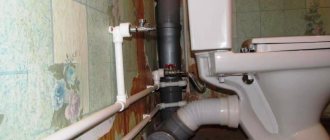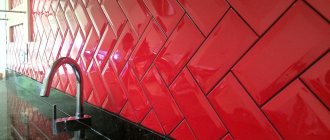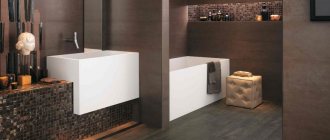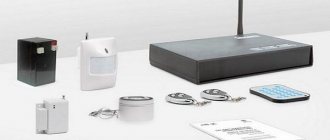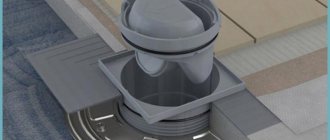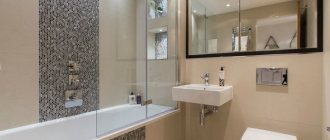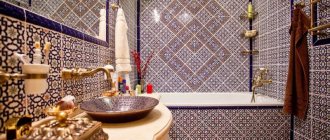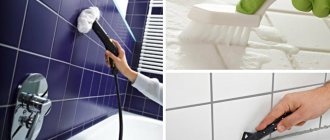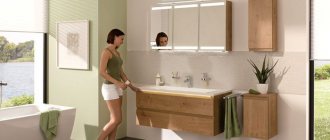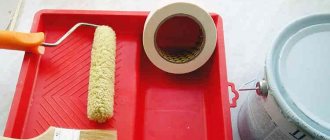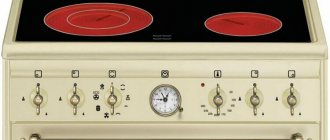Ceramics is the most common material for making facing tiles. It is widely used for aprons over the work surface in the kitchen, for tiling bathrooms, toilets, and showers. Let's consider which tile is better: matte or glossy for the bathroom, the advantages and disadvantages of both types of material.
Peculiarities
Ceramic tiles are popular due to their many qualities:
- aesthetic appearance;
- the ability to create an original design thanks to a wide range of colors and shades;
- the material is waterproof and fireproof, due to which it is used in baths and saunas;
- environmental friendliness;
- ease of care is one of the most important features;
- ease of installation;
- durability of the material with proper use.
The advantages of this material can be listed endlessly.
It is important to note that it is easy to care for; to clean it, just wipe with a sponge and a special product.
With proper care, mold will not grow on the tiles. Even a novice builder can handle the installation work.
Ceramic tiles differ not only in color, patterns, shapes, materials, but also in surface texture, and they are divided into 2 main types: glossy and matte.
A little about the features of ceramic tiles
In order to avoid getting into an unpleasant situation when the wrong choice of finishing material became the reason for a not entirely successful repair, you need to know some fundamental things about it.
Ceramic tiles for installation in the bathroom differ in many ways:
- dimensions;
- form;
- manufacturing method;
- color and design, etc.
Each manufacturer decides for himself what shape and size the ceramic tiles he produces will be. For many, this is a kind of calling card. Classic options assume sizes of 15*20 cm, 20*30 cm, 30*30 cm, which also determine the shape - square or rectangle. However, more exotic options are also available on the market. In an effort to distinguish their products from the competition, manufacturers often resort to various experiments, thanks to which you can find curved ceramic tiles, rhombic and other exclusive shapes and sizes in stores.
The tiles also differ in the manufacturing method. In this case, the initial stage of production is always the same - the main mixture is kneaded, which is then given its final shape and dried. In the future, the processing method that will be used in subsequent stages of working with the tile will determine its final appearance and properties.
Glossy finish
Glossy tiles are a facing material characterized by a shiny and smooth surface.
It can be used on any surface in different types of rooms.
When renovating a bathroom, such tiles can be laid on the walls, floor or ceiling.
Glitter can visually enlarge a room and give it a noble look. It is worth considering that a smooth surface on the floor can cause falls and injuries.
Tile with a glossy surface has a number of advantages and disadvantages that you need to familiarize yourself with before purchasing.
We also recommend watching - Classification and selection of tiles for the bathroom: photo and design
Advantages
- shine adds aesthetics to the room;
- the glossy surface reflects light, and the room becomes lighter (this is important if there are not enough lamps);
- even dark tiles make the bathroom look larger;
- easy to maintain, easy to clean.
Another advantageous quality is ease of installation.
It applies to all types of tiles. Modern elastic solutions and adhesives make it possible to cladding walls quickly and easily.
Pre-screeding and leveling need not be done if the depth of the flaws is no more than 1 cm.
Flaws
In addition to a number of advantages, glossy surfaces have some disadvantages:
- When cleaning, do not use abrasive powder cleaners so as not to scratch the surface;
- When water gets in, marks and smudges remain on the tiles.
It is better not to lay smooth material on the floor for 2 reasons:
- soiling, due to which the floor will always seem dirty even from traces;
- danger of falling, because a person can slip even on a drop of water and get injured.
Some installation nuances
When installing glossy floor tiles, certain rules must be followed. The most important condition is the prepared surface - this can be a regular, semi-dry and dry screed, or a smooth concrete floor. The base must be covered with a primer.
Laying is done with tile adhesive, which is applied to the base with a comb trowel. If the tile has an increased density (class BI), then a layer of glue is also applied to its reverse side “to tear off”. That is, it is removed with a spatula or small tool, after which a thickness of no more than 0.5 mm remains.
The smoother the base, the easier it is to lay ceramic tiles, but, nevertheless, they are constantly checked with a level or construction rule so that there are no differences in the plane. It is advisable to grout the joints no earlier than 3 days after installation, when you can already walk on the floor without causing harm to it.
Matte finish
Matte tiles have a more porous structure and a rough surface without shine. It will also allow you to create a cozy interior with high-quality and durable coating.
Advantages
A matte surface is no better or worse than a glossy one, it's just different. Such tiles can be made from clay, ceramics or porcelain stoneware.
It can be used in every room. Due to the porous and rough surface, tiles are non-slippery, which makes them the best material for flooring in bathrooms and bathrooms where the risk of falls is increased.
The matte surface is resistant to chemicals; you can use various chemicals to clean and disinfect walls and floors.
Flaws
Due to the textured surface, this material absorbs dirt and promotes the proliferation of pathogens.
The cost of such tiles is slightly higher, although it all depends on the manufacturer, collection, size and other parameters.
Classification by water absorption
In this case, water absorption is the ability of glossy floor tiles to absorb moisture. Moisture absorption directly depends on the porosity of the material and affects its mechanical properties. Porous or “soft” tiles cut very well, but also break and crack easily from impacts.
With a decrease in water absorption, the density of the structure increases - the coating is cut worse, but its mechanical strength increases. Gloss typically has lower water absorption than matte finishes due to sanding. There are three categories, these are:
- B-III is the most porous class of material, which absorbs moisture more than 10% of its mass. For use exclusively on walls and ceilings;
- B-II - such tiles can be used for flooring, but only indoors, since they are not frost-resistant. Can absorb 3-6% of its weight in moisture;
- BI - belongs to the frost-resistant class of coating, since such tiles absorb no more than 0.5-3% of water. It can be used not only in entrances, but also on the street (porch, blind area, etc.).
How to choose
When choosing a material, first of all, you need to start from the desires of the owner and the intended interior.
You cannot compare glossy and matte tiles, because these are 2 different building materials, and each of them has its own advantages and disadvantages.
First you need to weigh the pros and cons:
- Glossy tiles look beautiful when they are completely polished. In everyday conditions, finger stains and water stains remain on it. On a matte finish, all errors are less visible.
- If there is a person with allergies in the house, it is better to veneer it with gloss, because... The matte surface is porous and can harbor fungus and bacteria.
- Visually, both types of tiles look good and aesthetically pleasing, but a shiny and reflective surface can visually make a room larger.
- If the housewife does not have enough time and desire for constant cleaning and cleaning, it is better to choose matte tiles.
- In poor lighting, it is better to place a shiny surface to make the room seem brighter.
Glossy tiles - disadvantages and advantages
Tiles with a shiny surface are a classic option for decorating bathroom walls. Glazed elements are used in stylish, expensive interiors in the Art Nouveau, Art Deco styles, as well as in most standard renovation solutions.
The reflective surface optically enlarges a small room and makes it more voluminous.
Using glossy tiles on the floor poses some difficulties:
- slippery;
- increased requirements for strength and resistance to abrasives - and therefore the price per square meter;
- lack of chamfer to achieve a mirror effect;
- the need for a perfectly leveled floor so that the reflection is even;
- very frequent cleaning - any stain or even a looming layer of dust spoils the whole effect.
The best adhesive for non-woven wallpaper: top 5 according to the editors
You hung wallpaper and it fell off the next day? Have bubbles, strange spots appeared, has the drawing become swollen? It's a shame that this happened to expensive non-woven wallpaper. This is partly because the adhesive composition was selected incorrectly - without taking into account the specifics and reputation of the manufacturer. Which adhesive for non-woven wallpaper is better? We present our editorial top 5.
Thus, when deciding which tile to choose – matte or glossy, pay attention to the conditions under which it will be used.
Useful tips
Before choosing tiles yourself, it is recommended to rely on the advice of professionals:
- It is better to choose rough tiles as a bathroom flooring to reduce the risk of falls;
- if the design is combined and 2 types of tiles are used for finishing, it is better to line the apron near the sink with a glossy material, as it is easier to clean;
- For large rooms you can use large tile sizes, and for small ones - small ones;
- For miniature rooms it is better to use gloss on the walls, it will enlarge the room, and for large rooms it is better to use a matte surface to create coziness.
In the end, we note that it is impossible to say unequivocally which tile is better for tiling a bathroom. Both types have advantages and disadvantages.
You can use both rough and shiny tiles for walls, floors and ceilings. If gloss is chosen for the flooring, you need to remember safety and lay PVC or rubberized mats near the bathtub or shower stall.
You can lay tiles on walls in many ways: vertically, horizontally, mosaic, diagonally, etc. With high-quality installation and proper care, the tiles will last for decades.
Don’t forget to also look - Recommendations: which tiles are best to choose for the bathroom
Determining the design
Before you start renovating your bathroom, you need to prepare a design project. But first, a design style is chosen. It can be anything, it all depends on the taste of the owners.
The differences between the styles are:
- in space zoning,
- in the rational distribution of bathroom space,
- in expanding or reducing free space,
- in decorating facing materials,
- in combination of tone and texture of materials,
- convenient location of plumbing fixtures.
You should also familiarize yourself with the rules of interior design.
- Choice of colors. The bathroom palette is selected depending on the size of the room. For small rooms, choose one color and up to 3 shades of it. It can be white, black, beige, gold or interspersed with contrasting shades.
- The design of the bathroom can be in the same style as the apartment. It should not be overloaded with furniture and decor. This applies to both large and small rooms.
- Tiles for floors and walls are selected in tones of different intensities. The top is lighter, the bottom is darker. For small rooms, the color intensity between the floor and walls should differ by a couple of tones.
- With plain walls, the floor is made with tiles with a pattern or plain in different ways. This will avoid boredom in the interior of the bathroom and emphasize its modernity and style.
- Plumbing fixtures are most often chosen in a universal white palette. The color scheme may be different if provided for in the design project.
- Furniture can be matching tiles or contrasting, if required by the design project.
And tile size
The tiles are chosen in such a size that trimming is minimal. Square tiles measuring 20x20 cm look good on the walls and do not waste much; they are used for wall cladding. The tiles can be of other sizes.
Floor tiles are available in square and rectangular shapes. Standard sizes range from 10x10 to 60x60 cm for square shapes and from 20x10 to 40x30 cm for rectangular porcelain floor tiles. In a modern interior, bathroom tiles of 20x50 cm and other non-standard sizes can be used, if required by the design project.
High gloss enamel (varnish)
Facades with enamel under glossy varnish.
Behind the simple phrase “painted facades” lies a complex technology for their production: primer, enamel and varnish are applied in several layers, all this is dried, sanded and polished many times, and finally the product is also coated with wax. Manufacturers offer glossy furniture with straight and radius facades. Their basis is a moisture-resistant MDF board. The technology allows you to paint the ends of the product in addition to the front surface. In this case, moisture is unlikely to get inside. A factory with its own workshop is not tied to the mass colors of the material manufacturer, but chooses them itself. Some factories paint products in the color chosen by the customer. The hiding power of enamel is less than that of plastic, but final grinding and polishing removes all defects. The complex process of manufacturing painted facades affects the price, but provides high quality.
Advantages of painted facades:
- high gloss;
- many colors;
- restored by polishing;
- environmentally friendly;
- can be straight or radial;
- tolerate changes in temperature and humidity well.
Disadvantages of painted facades:
- Do not wash with aggressive cleaning agents;
- leave hand marks;
- high price.
